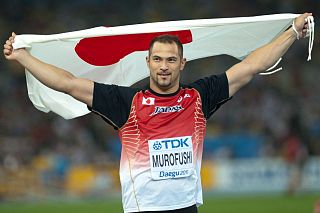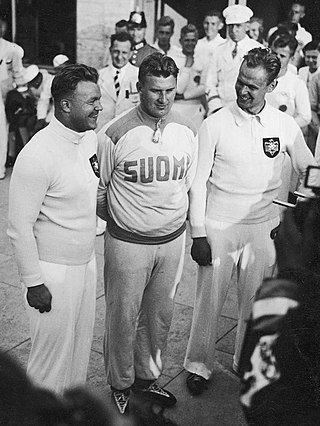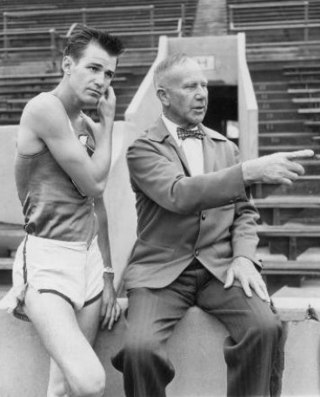
The men's hammer throw competition at the 2004 Summer Olympics in Athens was held at the Olympic Stadium on 20–22 August. There were 35 competitors from 24 nations. After a series of doping-related disqualifications, the event was won by Koji Murofushi of Japan, the nation's first medal in the event. All distances are given in metres.

The men's hammer throw was one of four men's throwing events on the Athletics at the 1964 Summer Olympics program in Tokyo. It was held on 17 October and 18 October 1964, with the qualification on the first day and the final the next. 25 athletes from 14 nations entered, with 1 not starting in the qualification round. The maximum number of athletes per nation had been set at 3 since the 1930 Olympic Congress. The event was won by Romuald Klim of the Soviet Union, the nation's second consecutive victory in the men's hammer throw. Gyula Zsivótzky of Hungary repeated as silver medalist, the fifth man to win multiple medals in the event. Uwe Beyer took bronze, the first medal for the United Team of Germany and the first medal for any German hammer thrower since 1952.

The men's hammer throw was an event at the 1996 Summer Olympics in Atlanta, Georgia. There were 37 competitors from 22 nations, with twelve athletes reaching the final. The maximum number of athletes per nation had been set at 3 since the 1930 Olympic Congress. The eight highest-ranked competitors after three rounds qualified for the final three throws to decide the medals. The qualification mark was set at 76.50 metres. The event was won by Balázs Kiss of Hungary, the nation's first victory in the men's hammer throw since 1968 and fourth overall. Lance Deal earned the United States' first medal in the event since 1956 with his silver. Oleksandr Krykun's bronze gave Ukraine a medal in its debut as an independent nation.

The men's hammer throw was an event at the 1984 Summer Olympics in Los Angeles, California. There were 23 participating athletes from 13 nations. The maximum number of athletes per nation had been set at 3 since the 1930 Olympic Congress. The eight highest-ranked competitors after three rounds qualified for the final three throws to decide the medals. The qualification mark was set at 72.00 metres.

The men's hammer throw at the 2008 Summer Olympics took place on 15 August (qualifying) and 17 (final) at the Beijing National Stadium. There were 33 competitors from 26 nations. The event was won by Primož Kozmus of Slovenia, the nation's first medal in the event.

The men's hammer throw at the 2000 Summer Olympics as part of the athletics program was held at the ANZ Stadium on Saturday, 23 September and Sunday, 24 September. There were 44 competitors from 24 nations. The event was won by Szymon Ziółkowski of Poland, the nation's first victory in the event and first medal of any color in the men's hammer throw since 1960. Silver went to Nicola Vizzoni, the first medal winner in the event for Italy. Igor Astapkovich, who had won a silver medal on the Unified Team in 1992, took bronze for the first medal credited to Belarus in the event. Astapkovich was the 11th man to win multiple medals in the hammer throw.

The men's shot put event was part of the track and field athletics programme at the 1936 Summer Olympics. The competition was held on 2 August 1936. Twenty-two athletes from 14 nations competed. The maximum number of athletes per nation had been set at 3 since the 1930 Olympic Congress. The final was won by Hans Woellke of Germany. It was Germany's first victory in the men's shot put, and first medal since bronze in 1928. Germany also received bronze in 1936, with Gerhard Stöck finishing third. Between the two Germans was Sulo Bärlund of Finland with silver, the nation's first medal in the event since gold in 1920. For the first time, the United States won no medals in the men's shot put, with the three Americans finishing 4th, 5th, and 6th.

The men's discus throw event was part of the track and field athletics programme at the 1936 Summer Olympics. The competition was held on August 5, 1936. Thirty-one athletes from 17 nations competed. The maximum number of athletes per nation had been set at 3 since the 1930 Olympic Congress. The final was won by Ken Carpenter of the United States. It was the nation's fourth consecutive, and seventh overall, victory in the men's discus throw; it was also the second consecutive Games that the Americans finished with both of the top two places, as Gordon Dunn took silver. Giorgio Oberweger earned Italy's first men's discus throw medal with his bronze.

The men's 200 metres sprint event at the 1948 Summer Olympics took place between 2 August and 3 August. There were 51 competitors from 28 nations. The maximum number of athletes per nation had been set at 3 since the 1930 Olympic Congress. The final was won by American Mel Patton. His countryman Barney Ewell earned silver, making this the third consecutive Games the United States took the top two spots in the event. Lloyd La Beach's bronze gave Panama a medal in its debut in the event.

The men's 800 metres event at the 1948 Olympic Games took place July 30, July 31 and August 2. Forty-one athletes from 24 nations competed. The maximum number of athletes per nation had been set at 3 since the 1930 Olympic Congress. The final was won by the American Mal Whitfield. It was the first of Whitfield's two wins in the event, the second of four consecutive American victories, and the fifth overall United States win in the 800 metres. Arthur Wint earned Jamaica's first Olympic medal in their debut games with silver; he would take gold in the 400 metres a few days later. Marcel Hansenne took France's first 800 metres medal with bronze.

The men's triple jump event was part of the track and field athletics programme at the 1948 Summer Olympics. The competition was held on 3 August 1948. Twenty-eight athletes from 17 nations competed. The maximum number of athletes per nation had been set at 3 since the 1930 Olympic Congress. The final was won by Arne Åhman of Sweden. It was Sweden's first victory in the event since 1912, and first medal since 1932. Australia reached the podium for the second Games in a row with Gordon George Avery's silver. Turkey received a medal in its first appearance in the triple jump with Ruhi Sarialp's bronze; it was the only track and field athletics medal won by Turkey in the 1900s.

The men's high jump event was part of the track and field athletics programme at the 1948 Summer Olympics. The competition was held on July 30, 1948. Twenty-seven athletes from 16 nations competed. The maximum number of athletes per nation had been set at 3 since the 1930 Olympic Congress. The final was won by John Winter of Australia. It was Australia's first victory in the men's high jump, and only the second time a jumper from outside the United States had won. Bjorn Paulson earned Norway's first medal in the event with a silver. George Stanich took bronze, keeping alive the United States' streak of medaling in every edition of the men's high jump.

The men's shot put event was part of the track and field athletics programme at the 1948 Summer Olympics. Twenty-four athletes from 15 nations competed. The maximum number of athletes per nation had been set at 3 since the 1930 Olympic Congress. The competition was held on 3 August. The final was won by American Wilbur Thompson. Thompson's compatriots, Jim Delaney and Jim Fuchs took 2nd and 3rd place. It was the ninth time that an American had won the event, and the fifth time that the Americans had swept the medals.

The men's discus throw event was part of the track and field athletics programme at the 1948 Summer Olympics. Twenty-eight athletes from 18 nations competed. The maximum number of athletes per nation had been set at 3 since the 1930 Olympic Congress. The competition was held on August 2. The final was won by Adolfo Consolini of Italy. It was the nation's first victory in the men's discus throw; Italy had previously taken bronze in 1936. Giuseppe Tosi earned silver to put Italy in the top two places. Fortune Gordien of the United States won bronze, keeping the Americans on the podium in each appearance of the men's discus throw to date.

The men's hammer throw at the 1960 Summer Olympics took place on September 2 (qualifying) and September 3 (final) at the Stadio Olimpico. The qualifying standards for the 1960 event were 60 m. There were 28 competitors from 18 nations. The maximum number of athletes per nation had been set at 3 since the 1930 Olympic Congress. The event was won by Vasily Rudenkov of the Soviet Union, the nation's first victory in the event. Gyula Zsivótzky took silver, Hungary's fourth medal in the last four Games in the men's hammer throw. Tadeusz Rut's bronze was Poland's first medal in the event.

The men's hammer throw competition at the 2012 Summer Olympics in London, United Kingdom was held at the Olympic Stadium on 3–5 August. There were 41 competitors from 32 nations. The event was won by Krisztián Pars of Hungary, the nation's first victory in the men's hammer throw since 1996 and fifth overall. Primož Kozmus of Slovenia, the 2008 winner, took silver. Koji Murofushi of Japan, the 2004 winner, took bronze. Kozmus and Murofoshi were the 12th and 13th men to earn multiple medals in the hammer throw.

The men's hammer throw field event at the 1972 Summer Olympics took place on September 4 & 7. There were 31 competitors from 17 nations. The maximum number of athletes per nation had been set at 3 since the 1930 Olympic Congress. The event was won by Anatoliy Bondarchuk of the Soviet Union, the nation's third victory in the men's hammer throw. Fellow Soviet Vasiliy Khmelevskiy took bronze. Silver went to Jochen Sachse of East Germany, the nation's first medal in the event. The Soviet Union's medal streak in the event extended to five Games, while Hungary's ended after three Games.

The men's hammer throw event at the 1952 Summer Olympics took place on 24 July at the Helsinki Olympic Stadium. There were 33 competitors from 18 nations. The maximum number of athletes per nation had been set at 3 since the 1930 Olympic Congress. The event was won by József Csermák of Hungary, the nation's second consecutive victory in the event. Imre Németh, who had won four years earlier, took bronze; he was the fourth man to win multiple medals in the event. Silver went to Karl Storch of Germany.

The men's hammer throw competition at the 1968 Summer Olympics in Mexico City, Mexico took place on October 16–17. There were 22 competitors from 12 nations. The maximum number of athletes per nation had been set at 3 since the 1930 Olympic Congress. The event was won by Gyula Zsivótzky of Hungary, who had taken silver in both 1960 and 1964; he was the third man to win three medals in the hammer throw (after John Flanagan and Matt McGrath. Zsivótzky defeated defending champion Romuald Klim of the Soviet Union, who earned silver this time to become the sixth man to win multiple medals in the event. Bronze went to Lázár Lovász of Hungary.

The men's hammer throw was a competition at the 2016 Summer Olympics in Rio de Janeiro, Brazil. The event was held at the Estádio Olímpico João Havelange between 17–19 August. There were 32 competitors from 24 nations. The event was won by Dilshod Nazarov of Tajikistan, the nation's first medal in the men's hammer throw and first gold medal in any Olympic event. Ivan Tsikhan of Belarus took silver, the 14th man to win multiple medals in the event in adding to his 2008 bronze. Bronze went to Wojciech Nowicki of Poland, the nation's first medal in the event since 2000.





















